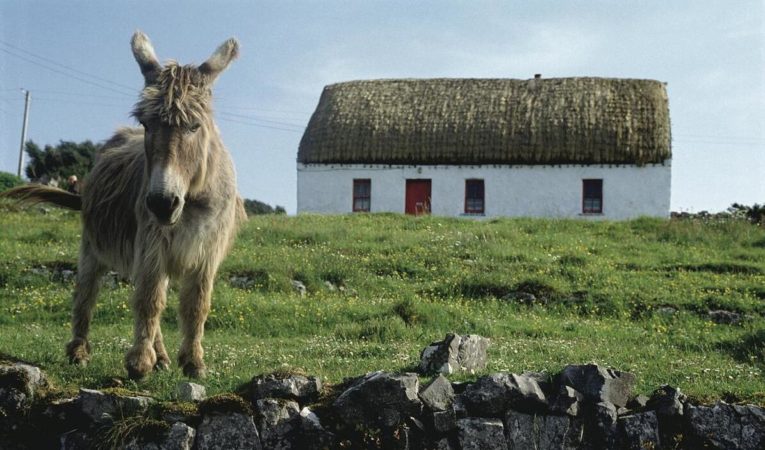Ireland consists of a wide central lowland area, surrounded by ridges in several groups. The lowlands rarely rise above 120 meters, except in places where isolated mountain ridges and plateaus shoot up over the flat or undulating terrain. The bedrock is mostly limestone, often with karst phenomena such as underwater rivers and caves. The majority of the lowland surface consists of meadows, grasslands, marshes and lakes. The plain reaches the coast to the east, where the capital Dublin is located.
The highlands that form the border around the lowlands include in the west and north the mountains of western Connacht and Donegal. They consist of heavily transformed slate and eruptives, and are a continuation of the Caledonian fold zone in Scotland and western Scandinavia. The highest peaks are Errigal (752 masl) in the northwest and Nephin (806 masl) in the far west. The mountains in the south are made up of carbonic limestone folded by the Hercynian mountain range, and of red sandstone from Devon. Macgillicuddy’s Reeks in the southwest is Ireland’s highest mountain massif, with the Carrantuohill (1041 m asl) the highest point of the island. The eastern highlands include the Wicklow Mountains, which consist of granite. The highest peak here is Lugnaquilla (926 masl).
Almost all of Ireland was covered by glaciers during the last ice age, and the moraine deposits cover much of the island. Elongated piles of bottom mounds ( drumlin ) form higher parts of the plain. Ireland is rich in ants and peat deposits. The west coast is heavily carved and rugged, with many islands off. Here lies, among other things. Aran, Achill and Valentia. Ireland has many rivers with great and steady water flow. Ireland’s longest river, Shannon, drains 1/5 of the island.
The Lakes of Killarney in the southwest is known for its beautiful scenery and has great tourist traffic.
Climate in Ireland
Ireland has a temperate coastal climate, with a mild, humid and very changing weather. The average air transport is for all seasons from around the west. Migrant low-pressure, often with breeze, and rainfall areas followed by northwest winds with city guns are typical. However, the variation in circulation is large; In some periods, high pressure can block the impact of the ocean, while local radiation conditions dominate. In winter it gets cold, down to -20 ° C. In summer hot, up to approx. 32 ° C. In some periods, the prevailing air transport is from the east; this is characteristic of the few, severe winters with frost and snow.
Average annual temperature is about 10 ° C. Valentia Island off the southwest coast has average temperatures of 7 ° C in January – February and 15 ° C in July – August. Dublin on the east coast has approx. 5 ° C in January and 15 ° C in July – August. The cloud cover is relatively large, averaging approx. 75 percent. The rainfall is frequent, but rarely sterile; it is common with approx. 180 precipitation days per year in the southeast, 260 in the northwest. Most precipitation falls in late autumn or early winter, at least in spring. As a means for the country, the annual sum is approx. 1200 mm; at least it falls around Dublin by 750 mm, most over the higher altitude within the west coast by 1400-2000 mm.
From the Aran Islands off the Gulf of Galway. Here is a simple farming and fishing.

